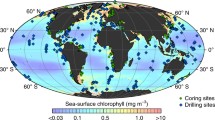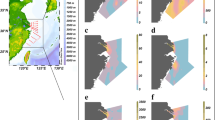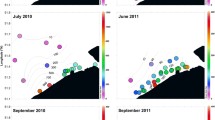Abstract
Estimating the amount of methane in the seafloor globally as well as the flux of methane from sediments toward the ocean–atmosphere system are important considerations in both geological and climate sciences. Nevertheless, global estimates of methane inventories and rates of methane production and consumption through anaerobic oxidation in marine sediments are very poorly constrained. Tools for regionally assessing methane formation and consumption rates would greatly increase our understanding of the spatial heterogeneity of the methane cycle as well as help constrain the global methane budget. In this article, an algorithm for calculating methane consumption rates in the inner shelf is applied to the gas-rich sediments of the Belt Seas and The Sound (North Sea–Baltic Sea transition). It is based on the depth of free gas determined by hydroacoustic techniques and the local methane solubility concentration. Due to the continuous nature of shipboard hydroacoustic measurements, this algorithm captures spatial heterogeneities in methane fluxes better than geochemical analyses of point sources such as observational/sampling stations. The sensibility of the algorithm with respect to the resolution of the free gas depth measurements (2 m vs. 50 cm) is proven of minor importance (a discrepancy of <10%) for a small part of the study area. The algorithm-derived anaerobic methane oxidation rates compare well with previous measured and modeling studies. Finally, regional results reveal that contemporary anaerobic methane oxidation in worldwide inner-shelf sediments may be an order of magnitude lower (ca. 0.24 Tmol year–1) than previous estimates (4.6 Tmol year–1). These algorithms ultimately help improve regional estimates of anaerobic oxidation of methane rates.









Similar content being viewed by others
References
Anderson AL, Abegg F, Hawkins JA, Duncan ME, Lyons AP (1998) Bubble populations and acoustic interaction with the gassy floor of Eckernförde Bay. Cont Shelf Res 18:1807–1838. doi:10.1016/S0278-4343(98)00059-4
Bohrmann G, Torres ME (2006) Gas hydrates in marine sediments. In: Schulz HD, Zabel M (eds) Marine geochemistry, 2nd edn. Springer, Berlin, pp 481–512
Bohrmann G, Ivanov M, Foucher J-P, Spiess V, Bialas J, Greinert J, Weinrebe W, Abegg F, Aloisi G, Artemov Y, Blinova V, Drews M, Heidersdorf F, Krabbenhoft A, Klaucke I, Krastel S, Leder T, Polikarpov I, Saburova M, Schmale O, Seifert R, Volkonskaya A, Zillmer M (2003) Mud volcanoes and gas hydrates in the Black Sea: new data from Dvurechenskii and Odessa mud volcanoes. Geo-Mar Lett 23(3/4):239–249. doi:10.1007/s00367-003-0157-7
Dale AW, Van Cappellen P, Aguilera DR, Regnier P (2008a) Methane efflux from marine sediments in passive and active margins: estimations from bioenergetic reaction-transport simulations. Earth Planet Sci Lett 265:329–344. doi:10.1016/j.epsl.2007.09.026
Dale AW, Aguilera DR, Regnier P, Fossing H, Knab NJ, Jørgensen BB (2008b) Seasonal dynamics of the depth and rate of anaerobic oxidation of methane in Aarhus Bay (Denmark) sediments. J Mar Res 66:127–155
Dale AW, Regnier P, Van Cappellen P, Fossing H, Jensen JB, Jørgensen BB (2009) Remote quantification of methane fluxes in gassy marine sediments through seismic survey. Geology 37(3):235–238. doi:10.1130/G25323A.1
Dickens GR (2011) Down the Rabbit Hole: toward appropriate discussion of methane release from gas hydrate systems during the Paleocene-Eocene thermal maximum and other past hyperthermal events. Clim Past 7:831–846. doi:10.5194/cp-7-831-2011
Duan Z, Mao S (2006) A thermodynamic model for calculating methane solubility, density and gas phase composition of methane-bearing aqueous fluids from 273 to 523 K and from 1 to 2000 bar. Geochim Cosmochim Acta 70(13):3369–3386. doi:10.1016/j.gca.2006.03.018
Duan Z, Møller N, Greenberg J, Weare JH (1992) The prediction of methane solubility in natural waters to high ionic strength from 0 to 250°C and from 0 to 1600 bar. Geochim Cosmochim Acta 56(4):1451–1460
Emery KO (1968) Relict sediments on continental shelves of world. AAPG Bull 52:445–464
Fleischer P, Orsi TH, Richardson MD, Anderson AL (2001) Distribution of free gas in marine sediments: a global overview. Geo-Mar Lett 21(2):103–122. doi:10.1007/s003670100072
Hermansen B, Jensen J (2000) Digital sea bottom sediment map around Denmark. Geol Soc Denmark and Greenland 68
Hinrichs K, Boetius A (2002) The anaerobic oxidation of methane: new insights in microbial ecology and biogeochemistry. In: Wefer G, Billet D, Hebbeln D, Jørgensen BB, Schlüter M, Van Weering TCE (eds) Ocean margin systems. Springer, Berlin, pp 457–477
Jensen JB, Bennike O (2009) Geological setting as background for methane distribution in Holocene mud deposits, Århus Bay, Denmark. Cont Shelf Res 29(5/6):775–784. doi:10.1016/j.csr.2008.08.007
Jensen JB, Bennike O, Witkowski A, Lemke W, Kuijpers A (1999) Early Holocene history of the southwestern Baltic Sea: the Ancylus Lake stage. Boreas 28(4):437–453. doi:10.1111/j.1502-3885.1999.tb00233.x
Jensen JB, Kuijpers A, Bennike O, Laier T, Werner F (2002) New geological aspects for freshwater seepage and formation in Eckernförde Bay, western Baltic. Cont Shelf Res 22(15):2159–2173. doi:10.1016/S0278-4343(02)00076-6
Jørgensen BB, Kasten S (2006) Sulfur cycling and methane oxidation. In: Schulz HD, Zabel M (eds) Marine geochemistry, 2nd edn. Springer, Berlin, pp 271–309
Krumins V, Gehlen M, Arndt S, Van Cappellen P, Regnier P (2013) Dissolved inorganic carbon and alkalinity fluxes from coastal marine sediments: model estimates for different shelf environments and sensitivity to global change. Biogeosciences 10:371–398. doi:10.5194/bg-10-371-2013
Kvenvolden KA, Ginsburg GD, Soloviev VA (1993) Worldwide distribution of subaquatic gas hydrates. Geo-Mar Lett 13(1):32–40. doi:10.1007/BF01204390
Laier T, Jensen JB (2007) Shallow gas depth-contour map of the Skagerrak-western Baltic Sea region. Geo-Mar Lett 27(2/4):127–141. doi:10.1007/s00367-007-0066-2
Leipe T, Tauber F, Vallius H, Virtasalo J, Uścinowicz S, Kowalski N, Hille S, Lindgren S, Myllyvirta T (2011) Particulate organic carbon (POC) in surface sediments of the Baltic Sea. Geo-Mar Lett 31(3):175–188. doi:10.1007/s00367-010-0223-x
McCutcheon S, Martin J, Barnwell TJ (1993) Water quality. In: Maidment D (ed) Handbook in hydrology, chap 11. McGraw-Hill, New York
Mogollón JM, L’Heureux I, Dale AW, Regnier P (2009) Methane gas-phase dynamics in marine sediments: a model study. Am J Sci 309:189–220. doi:10.2475/03.2009.01
Mogollón JM, Dale AW, L’Heureux I, Regnier P (2011) Impact of seasonal temperature and pressure changes on methane gas production, dissolution, and transport in unfractured sediments. J Geophys Res-Biogeosci 116, G03031. doi:10.1029/2010JG001592
Mogollón JM, Dale AW, Fossing H, Regnier P (2012) Timescales for the development of methanogenesis and free gas layers in recently-deposited sediments of Arkona Basin (Baltic Sea). Biogeosciences 9:1915–1933. doi:10.5194/bg-9-1915-2012
Moros M, Lemke W, Kuijpers A, Endler R, Jensen JB, Bennike O, Gingele F (2002) Regressions and transgressions of the Baltic basin reflected by a new high-resolution deglacial and postglacial lithostratigraphy for Arkona Basin sediments (western Baltic Sea). Boreas 31(2):151–162. doi:10.1080/030094802320129953
Pimenov NV, Ulyanova MO, Kanapatsky TA, Veslopolova EF, Sigalevich PA, Sivkov VV (2010) Microbially mediated methane and sulfur cycling in pockmark sediments of the Gdansk Basin, Baltic Sea. Geo-Mar Lett 30(3/4):439–448. doi:10.1007/s00367-010-0200-4
Regnier P, Dale AW, Arndt S, LaRowe D, Mogollón JM, Van Cappellen P (2011) Quantitative analysis of anaerobic oxidation of methane (AOM) in marine sediments: a modeling perspective. Earth Sci Rev 106:105–130. doi:10.1016/j.earscirev.2011.01.002
Thießen O, Schmidt M, Theilen F, Schmitt M, Klein G (2006) Methane formation and distribution of acoustic turbidity in organic-rich surface sediments in the Arkona Basin, Baltic Sea. Cont Shelf Res 26(19):2469–2483. doi:10.1016/j.csr.2006.07.020
Ulyanova M, Sivkov V, Kanapatskij T, Sigalevich P, Pimenov N (2012) Methane fluxes in the southeastern Baltic Sea. Geo-Mar Lett 32(5/6):535–544. doi:10.1007/s00367-012-0304-0
Wallmann K, Drews M, Aloisi G, Bohrmann G (2006) Methane discharge into the Black Sea and the global ocean via fluid flow through submarine mud volcanoes. Earth Planet Sci Lett 248(1/2):545–560. doi:10.1016/j.epsl.2006.06.026
Acknowledgements
We wish to thank Kerstin Jerosch for her help with the grain size classification system. Gerald Dickens, an anonymous reviewer and the editor provided constructive comments that improved the paper. This study was funded by NWO Vidi Award #864.05.007: Marine methane flux and climate change: from biosphere to geosphere, by the European Community’s Seventh Framework Programme (FP/2007–2013) under grant agreement number 217246 made with the joint Baltic Sea research and development programme BONUS, and by the government of the Brussels-Capital Region (Brains Back to Brussels award to P. Regnier). Further funding is acknowledged from the European Union’s Seventh Framework Program (FP7/2007-2013) under grant agreement no 283080, project GEOCARBON.
Author information
Authors and Affiliations
Corresponding author
Rights and permissions
About this article
Cite this article
Mogollón, J.M., Dale, A.W., Jensen, J.B. et al. A method for the calculation of anaerobic oxidation of methane rates across regional scales: an example from the Belt Seas and The Sound (North Sea–Baltic Sea transition). Geo-Mar Lett 33, 299–310 (2013). https://doi.org/10.1007/s00367-013-0329-z
Received:
Accepted:
Published:
Issue Date:
DOI: https://doi.org/10.1007/s00367-013-0329-z




